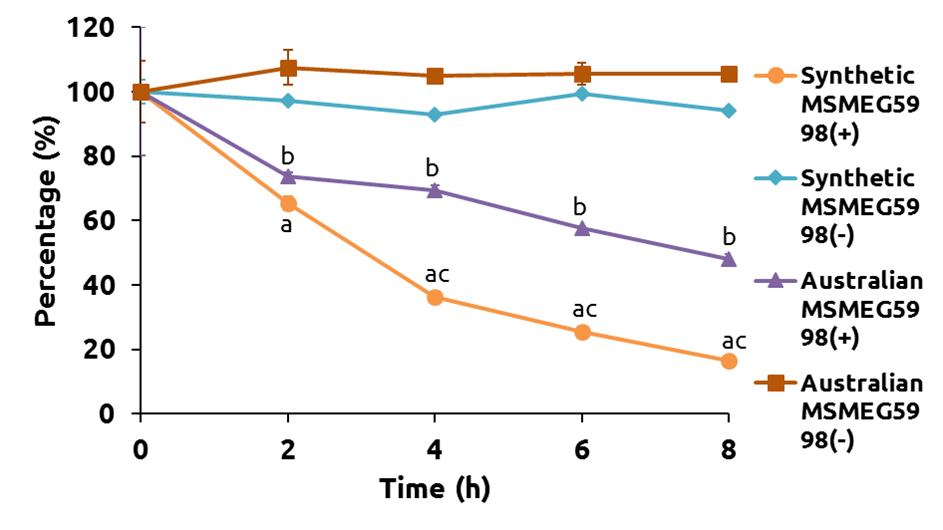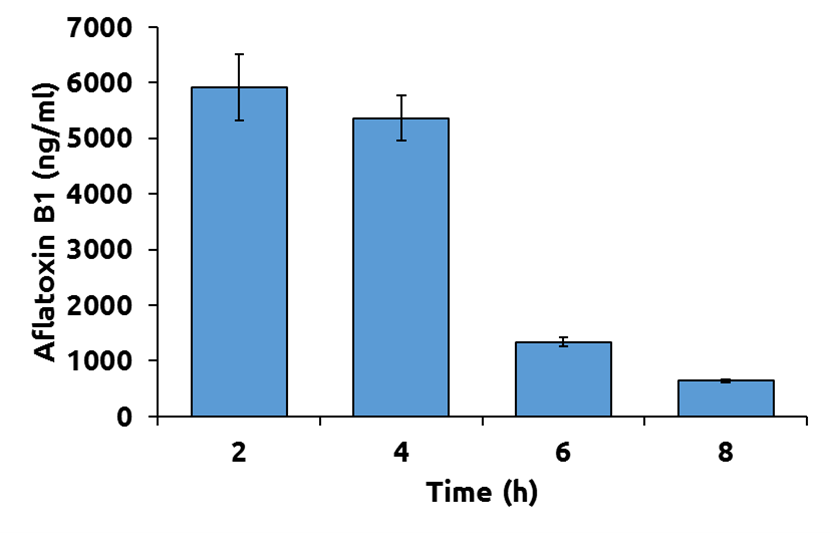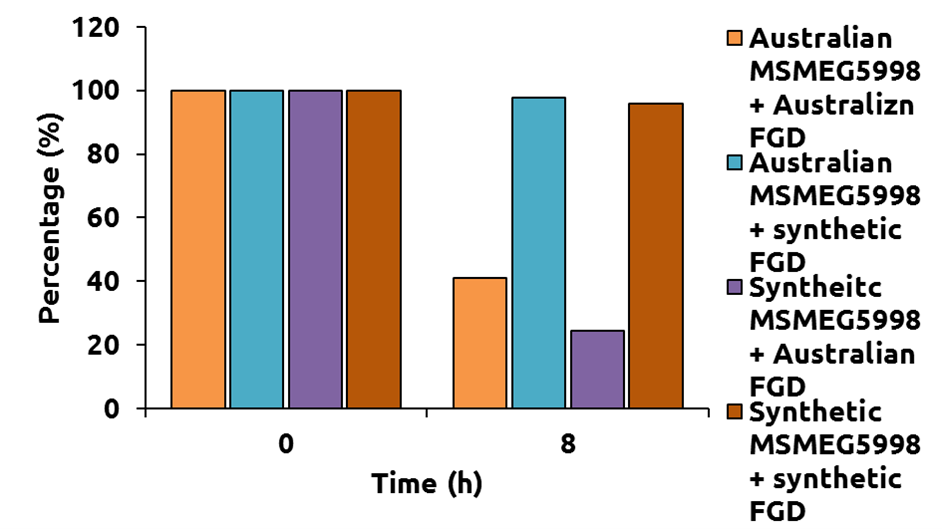Part:BBa_K2382006
T7 promoter + Thioredoxin-MSMEG_5998 fusion protein
Sequence and Features
- 10COMPATIBLE WITH RFC[10]
- 12COMPATIBLE WITH RFC[12]
- 21INCOMPATIBLE WITH RFC[21]Illegal BamHI site found at 456
Illegal XhoI site found at 462 - 23COMPATIBLE WITH RFC[23]
- 25INCOMPATIBLE WITH RFC[25]Illegal AgeI site found at 901
- 1000COMPATIBLE WITH RFC[1000]
Usage and Biology
This is an enzyme that could degrade aflatoxin with the aid of coenzyme F420. It belongs to the F420H2-dependent reductases family from Mycobacterium Smegmatis.
Contents
Characterization of the Thioredoxin-MSMEG_5998 fusion protein
Expression results
IPTG induction
Two of the composite parts (BBa_K2382005 and BBa_K2382006) were synthesized by Allbio Life Co., Ltd and put into the standard backbone pSB1C3. First, we transformed all of our plasmids, including two plasmids from Australia and two of our own composition parts into E. coli BL21 (DE3) strain to express our proteins. Then IPTG was used to induce the expression system since all plasmids in our project had T7 promoter. We sonicated E. coli and did 9500 rpm and 13000 rpm centrifugation to remove the cell pellet and obtain the supernatant. To confirm the suitable concentration of cell supernatant, we did SDS-PAGE electrophoresis and coomassie brilliant blue staining. The results is demonstrated in the Fig. 1B. After centrifuging two times, we could find a high percentage of proteins in the cell supernatant (the 13000 Su group)

Protein purification, and dialysis
After extracting the cell lysates, we used nickel-resin column to purify our target proteins from the cell lysates because all of our proteins were tagged with 6 histidines at their C-terminal ends. After protein purification, protein dialysis with diaysis buffer containing 150 mM NaCl, 20 mM Tris-HCl (pH=7.5), and 20% glycerol to remove imidazole in our purified proteins, we did SDS-PAGE gel electrophoresis to ensure our target proteins were successfully purified (Fig. 2A ). The molecular weights of these proteins are listed in the Table 1. The standard BSA proteins were used to quantify the concentration of target proteins.
| Proteins | Molecular weight |
| Synthetic MSMEG5998 | 32.4 kDa |
| Synthetic FGD | 51.5 kDa |
Protein solubility analysis
To know whether the solubility of our two enzymes (MSMEG_5998 and FGD BBa_K2382002) increased after fusing enzymes with thioredoxin, we dissolved all cell lysates which containing pellet and supernatant and did western blot to detect the content of our target proteins. All proteins were detected by anti-6x His Tag antibody because all of them contained a 6-histidines tail when bacteria expressed them. In Fig. 3, we could find there was good expression of both Australian and synthetic MSMEG5998 in the “13000 Su” group when compared with the “13000 P” group. This result meant that most proteins were dissolved in the supernatant while few proteins deposited in the cell pellet after 13000-rpm centrifugation. However, we could not observe good solubility in both Australian and synthetic FGD because there were little or no difference between the “13000 Su” group and the “13000 P” group.
Protein Expression Over Time
We transformed the plasmids that contained MSMEG_5998(BBa_K2382001) and Thioredoxin-MSMEG_5998 fusion protein(BBa_K2382009) respectively into competent cell E.coli BL21. After cultured overnight, measure the ABS600 and diluting the LB medium to O.D.=0.1. Then incubate at 37℃, 150 rpm until the O.D. of the samples reach 0.4 to 0.6 . Add 80ul 100mM IPTG( final concentration : 0.4mM ) to 125 ml flask and return to 37°C. From then on, after measure the O.D. values, transfer 1 ml from the induced sample and centrifuge at maximum speed for 60 seconds at RT and remove supernatant at 0, 1, 2, 3, 4, 5, 6, 7, 8 hours and 0, 0.5, 1.0, 1.5, 2.0 ,2.5 , 3.0, 3.5, 4 hours. Then we use Western Blot mehtod to amalyze the quantaty of MSMEG_5998 at each time spot.
Discussion
According to the data shown above, the growth curve of E.coli BL21 with Synthetic MSMEG_5998 reached the ceiling when the O.D. value was approximately at 2 while the amount of Synthetic MSMEG_5998 were still increasing.
Though the amount of Synthetic MSMEG_5998 increased consistently with time, we could not jump to conclusions that it was proper to incubate E.coli as long as possible. Another consideration was the time it would take. Just as our expected, it growed fast at the first 2.5 hours. That’s why we also chose 2.5hr after induced by IPTG when we extracted Synthetic MSMEG_5998 from total cell lysate in other experiments.
Based on previous experience, if the E.coli was incubated over 4 hours, the protein that it expressed may be degraded or mis-folded, leading to malfunction. As a result, it was also an important issue for this modeling. However, because of the lack of F420, we did not have the chance to check the enzyme activity of each time spot. It was still unknown whether the titer of the Synthetic MSMEG_5998 would change or not and awaited further research.
Enzyme Function Results
Enzyme Activity Assay
The conditions of reaction to degrade aflatoxin by MSMEG5998 were modified from Taylor’s study[6]. All concentrations of reactants are listed in Table 2 and 32 μM aflatoxin was used. We first mixed all reactants in eppendorfs and then put them at 22°C.
In Fig. 7A, we compared two proteins, MSMEG5998 and F420-dependent glucose-6-phosphate dehydrogenase (FGD) expressed from Taylor’s vectors (from Australia) and from our synthetic vectors. We found that both the Australian and synthetic MSMEG5998 have great activity and degraded aflatoxin B1 by more than 60%. The effect of the synthetic one may be better than the Australian one but there were no statistic significance.
| Name | Concentration |
| Aflatoxin B1 | 32 or 10 μM |
| MSMEG5998 | 0.1 μM |
| Reactants |
| Glucose-6-phosphate (G6P) | 2.5 mM |
| F420 | 5 μM |
| F420-dependent glucose-6-phosphate dehydrogenase (FGD) | 0.225 μM |
| Tris-HCl (pH=7.5) | 25 mM |
However, only Australian FGD has activity to reduce F420 into F420H2 and help the reaction. This finding corresponds with our dry lab results. Therefore, we used Australian and synthetic MSMEG5998 and Australian FGD to do the same experiment again to figure out whether the degradation percentage was dependent of time and whether the main reason of degradation was MSMEG5998.
</p>


The results were detected by direct 365 nm absorbance (Fig. 7B) and by ELISA (Fig. 7C). We found out that the degradation percentage was time-dependent. The synthetic MSMEG5998 had better activity than Australian MSMEG5998. The former was able to degrade 83% aflatoxin after 8 h while the latter could only degrade 52% aflatoxin.
References
(1)Taylor, M.C., et al., Identification and characterization of two families of F420H2‐dependent reductases from Mycobacteria that catalyse aflatoxin degradation. Molecular microbiology, 2010. 78(3): p. 561-575.
(2)Lapalikar, G.V., et al., F420H2-dependent degradation of aflatoxin and other furanocoumarins is widespread throughout the Actinomycetales. PLoS One, 2012. 7(2): p. e30114.//function/degradation
//proteindomain/degradation
| biology | Mycobacterium smegmatis |
| protein | T7 promoter + Thioredoxin-MSMEG_5998 fusion protein |






